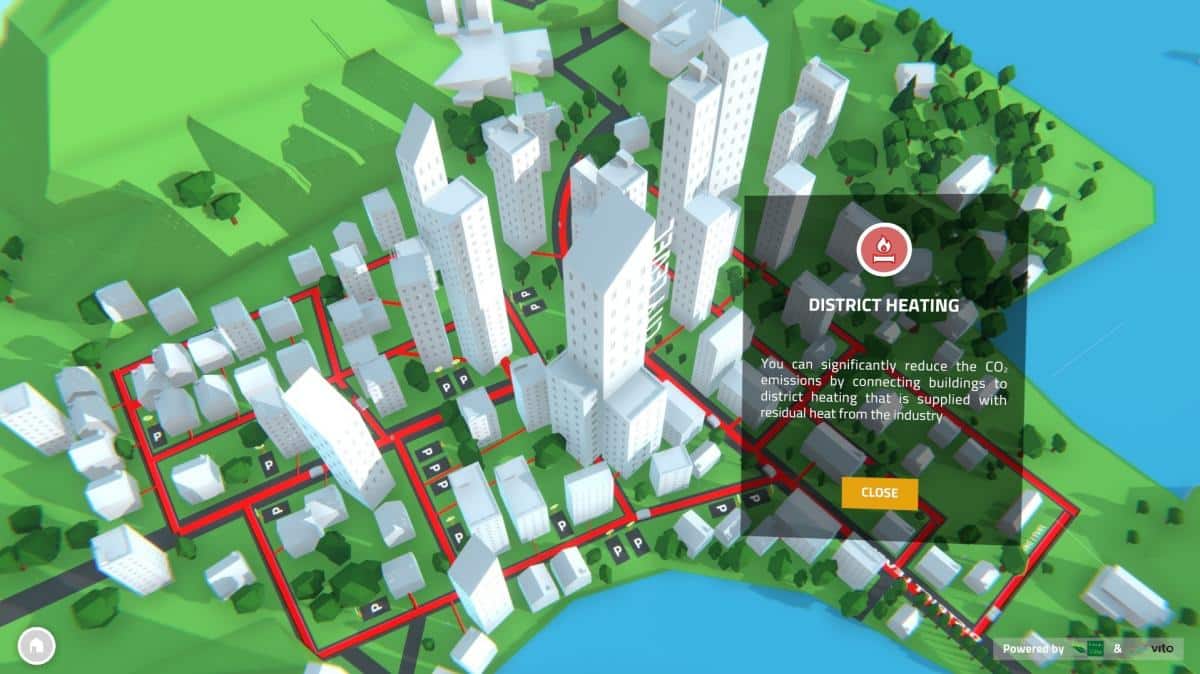Urban Energy Pathfinder
EnergyVille has developed a number of products and tools to support decision making and to monitor the impacts from building renovation and energy transition programmes and initiatives. These tools allow to shift between various levels of details/scope: from the building level to district, city and regional level. They also allow monitoring over the years. The latest development is the Urban Energy Pathfinder tool, designed for future scenario analysis for energy planning purposes.
The Urban Energy Pathfinder is a web-based multi-layer decision support tool for regions and cities who want to move consciously forward in the development of their energy transition pathways. It provides a holistic energy solution by calculating energy, CO2 savings, and financial conditions for renovation scenarios and energy technology measures at building, district and city level. The scenarios include a mix of technological measures such as district heating/cooling networks, building renovation measures and decentralised renewable energy production technologies. Taking all of these technologies into account, the Urban Energy Pathfinder allows our clients to design their pathways to energy autonomous districts and cities.

Advantages
The Urban Energy Pathfinder is a multi-energy vector (sun, wind, heat, biomass), multi-scale (from building level to regional level) web based decision support tool for reaching GHG emission reduction targets through a mix of energy efficiency measures and integration of renewables, allowing the user to define & calculate scenarios and their impact (energy, CO2, financial) to assist in energy master planning.

This service is suitable for:
- Utilities, energy suppliers or network distributors wanting to expand and diversify their energy service portfolio
- Cities and municipalities that want to analyse energy efficiency and renewable energy potential in their territory to assist in energy master planning and prioritise actions

The Urban Energy Pathfinder combines EnergyVille’s knowhow on energy analyses on the one hand and on GIS data processing and algorithms on the other hand. Methodologically, the approach within the tool relies on the following main elements:
- Definition of zones: These are areas of the city that are considered as entities to be examined separately (zone level) and as a whole (city level, all zones).
- Archetype classification: The Urban Energy Pathfinder performs calculations at building level by means of making use of zone archetype as the primary unit. Per zone, all buildings are classified into the best-suited archetype based on function, type (apartment, terraced, semi-detached, detached) and construction date.
- Primary characteristics and input data such as current actual energy consumption data are where needed transferred, processed, re-calulcated from higher aggregation levels towards the zone.archetype level by means of spatial algorithm processing.
- Secondary characteristics such as thermal characteristics of construction elements (u-values), heating systems performance, domestic hot water generation, renewable energy installations and others are taken into account in the background calculations performed by the Pathfinder.
- Scenario definition: The Urban Energy Pathfinder performs calculations at building level by means of making use of zone.archetype as the primary unit. The Pathfinder calculates the energy, environmental and financial impact for a selected package of measures (mix of energy efficiency, RES and efficient technology measures). The tool will disregard inappropriate measures per zone.archetype. On top of this inherent intelligence, the user can specify personal preferences and exclude other suggested measures from the calculation routine.
The results are presented per zone (district and building measures) and zone.archetype (building measures). The results at city level are also calculated as an aggregation of the zones results. The calculation results are visualised in a user-friendly table and graphs including energy, financial and environmental indicators.
Energy measures included (EU case study)
In Table 1, the selection of all measures included in the Urban Energy Pathfinder are displayed. They are related to energy efficiency, renewable energy sources and efficient technologies at archetype and at zone level. Measures are combined into packages for which the impact is calculated. District heating is included as a measure at district level and is always combined with compatible building energy measures in the calculation routines.

Table 1: The energy sources, technologies and energy efficiency measures are indicated.
Results
Table 2 shows the different indicators present in the tool. These Key Performance Indicators in the Urban Energy Pathfinder are grouped in three categories: energy, financial and environmental indicators.

Table 2: KPIs for energy, environmental and financial targets are indicated.

